|
Week 6: September 5-11, 2012 |
Welcome
to the McGill Bird Observatory weekly report.
Click here for a complete listing of our archives.
Comments or
questions are welcome at "mbo AT migrationresearch.org".
|
PICTURE
OF THE WEEK: |
|
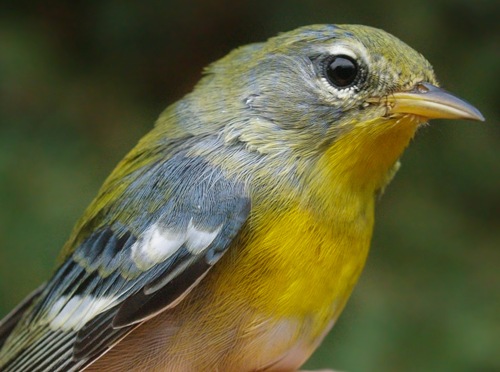
MBO's first Northern Parula of the 2012 fall season
(Photo by Simon Duval)
-
|
|
|
THIS WEEK |
THIS FALL |
2012 TOTAL |
SITE TOTAL |
|
# birds (and species) banded |
263 (41) |
1353 (65) |
2618 (82) |
38369 (108) |
|
# birds (and species) repeat |
65 (16) |
376 (32) |
714 (46) |
7127 (69) |
|
# birds (and species) return |
2 (2) |
43 (19) |
182 (27) |
1143 (38) |
|
# species observed |
86 |
121 |
159 |
207 |
|
# net hours |
547.0 |
3263.8 |
6523.6 |
65622.7 |
|
# birds banded / 100 net hours |
48.1 |
41.5 |
40.1 |
58.5 |
|
|
Note: table does not include nocturnal banding (owls) |
|
Banders-in-charge: Simon Duval, Gay Gruner
Assistants: Nicolas Bernier, Cindy Bouchard, David Davey, Rui de Jesus, Gail Desnoyer, Réjean Duval, Liette Fortier, Louise Gagné, Marie-France Gagnon, Monique Groulx, Alison Hackney, Frédéric Hareau, Lisa Keelty, Shelley Kirk, Barbara MacDuff, Francine Marcoux, Betsy McFarlane, Chris Murphy, Yves Payette, Lisa Rosenberger, Catherine Russell, Marilou Skelling, Bonnie Soutar, Alex Stone, Carine Touma, Gijs van Tol, Monique Venne
Notes: After a somewhat slow week 5, activity picked up again this week, with an above-average count of 263 birds banded, and a record-high 86 species observed, the latter also contributing to a record 120 species to date this season. Repeats continued to be frequent too, with the season total to date of 376 more than 80 ahead of the previous record pace at this point in 2008. Although it is becoming routine to report, the weather was again dry and cooperative this week, with only 13 of 560 potential net hours lost, and the total for the season nearly 200 net hours ahead of any previous year.
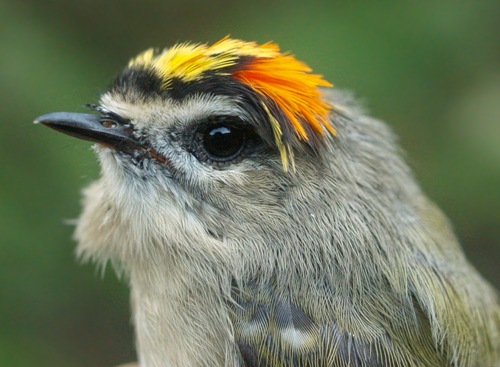
Some unusually early arrivals this week included the male Golden-crowned Kinglet above, and adult female Slate-colored Junco below.
(Photos by
Simon Duval)
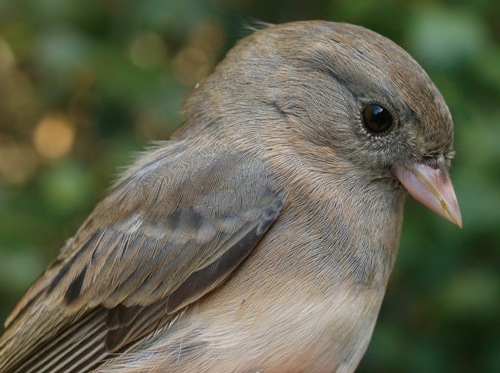 |
Again this week we had a good variety of new migrants arriving at MBO. The seven species observed for the first time this fall were Osprey, Marsh Wren, Golden-crowned Kinglet, Western Palm Warbler, White-crowned Sparrow, Slate-colored Junco, and Rusty Blackbird; all of these were observed previously this year though as part of the Spring Migration Monitoring Program. We also banded five species for the first time this fall, raising the total for the season to 64, also ahead of the pace set in all previous years. The new species in week 6 were House Wren (which we usually band several of in August but were strangely absent this year), Golden-crowned Kinglet (only twice before banded this early in fall), Northern Parula (pretty much right on time), Western Palm Warbler (also on schedule), and Slate-colored Junco (like the kinglet, only twice before banded so early in the season).
This week’s top 10 [last week's rank in brackets]
# individuals banded |
mean # individuals observed daily |
1. Magnolia Warbler (44) [1] |
1. Common Grackle (319) [1] |
2. Swainson's Thrush (24) [10] |
2. Canada Goose (46) [2] |
3. Blackpoll Warbler (21) [-] |
3. American Goldfinch (30) [4] |
4. Tennessee Warbler (20) [7] |
4. American Crow (22) [5] |
5. Wilson's Warbler (14) [-] |
5. Black-capped Chickadee (18) [3] |
5. Song Sparrow (14) [-] |
6. Blue Jay (16) [6] |
7. American Goldfinch (13) [-] |
7. White-throated Sparrow (14) [9] |
8. American Redstart (12) [3] |
8. Magnolia Warbler (11) [-] |
9. Gray Catbird (11) [-] |
9. Song Sparrow (8) [-] |
9. Nashville Warbler (11) [-]
|
10. Gray Catbird (8) [7] |
|
There was a high rate of turnover in the list of top species banded this week, with three of last week's top five falling out of the top ten for week 6 (Common Yellowthroat, Red-eyed Vireo, and White-throated Sparrow), along with another three (Purple Finch, Northern Waterthrush, and Chipping Sparrow). Magnolia Warbler remained the most frequently banded species for a second week in a row, the sixth time in eight years that it has pulled off this feat in week 6. Much more of a surprise was Swainson's Thrush in second place - it has never before appeared in the top ten in week 6, and the 24 individuals banded this week exceed the fall season total for five of seven previous years! Not surprisingly, the season total of 49 to date is already far in front of the previous record of 36 way back in 2005. Third place also held a mild surprise, with 21 Blackpoll Warblers being the most we've ever banded in a single week in fall. After appearing to taper off last week, Tennessee Warblers rebounded to fourth place, although the season total to date of 63 lags far behind the pace we have seen the past couple of years. Wilson's Warblers usually arrive in good numbers in week 5, but were a bit later this year, cracking the top five this week in a tie with Song Sparrow. American Goldfinch was a new addition this week, and American Redstarts are still moving in good numbers, still just behind Song Sparrow for the season lead, but with Magnolia Warbler quickly catching up. Gray Catbird and Nashville Warbler round out the top ten in a ninth place tie, but on opposite trajectories, with the catbird on pace for a record high this fall, and Nashville Warbler with the lowest count we've ever seen at this point in fall.
Unlike the species banded, the most common species observed changed little between weeks 5 and 6. The top six species were in fact the same both weeks, the only minor shift being that Black-capped Chickadee shifted down to fifth place from third. The dominance of Common Grackles became even more pronounced this week, with a mean daily count of 319, largely thanks to a massive flock of 1750 on the final day of the week. Common Grackle has now been the most abundant species for an unprecedented five weeks in a row, and Canada Goose has been the runner-up for the past four weeks, also highly unusual for this early in fall. White-throated Sparrow numbers are beginning to build, and it likely won't be long before they rise into the top five. Magnolia Warbler and Song Sparrow were new additions to the top ten this week, displacing Ring-billed Gull and American Robin.
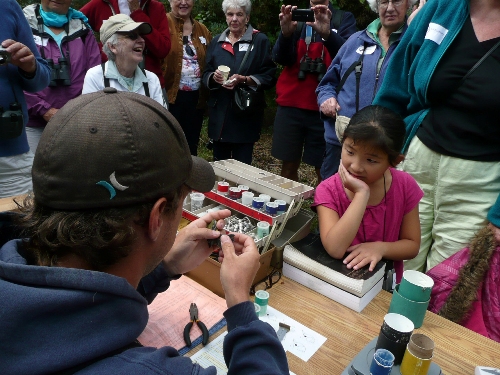
A young birder takes in the banding demonstration at our first Sponsor's Day on Sunday September 9. The day was held to thank generous sponsors who have donated to MBO through the Baillie Birdathon or other financial or in-kind contributions, and to show them what we do on a daily basis at MBO. Over 40 visitors attended, who had the opportunity to watch Simon band, accompany a censuser, visit the nets, and learn more about our research and education objectives.
The event was organized by volunteer Alison Hackney and made possible by a score of cheerful and efficient MBO volunteers. Guests enjoyed delicious refreshments prepared by volunteer Lima Kayello. Food was generously provided by Metro Plus E.T.S. from downtown Montreal and Marché J. Raymond Richard et Fils, Inc of Ste-Anne-de-Bellevue. The event was such a success that we have decided to make it an annual happening.
(Photo by
Gay Gruner)
|
Some species seem much scarcer than usual, while others have been recorded in higher numbers than ever before. It seems that every fall produces such contrasts, but so far this year it is difficult to discern any patterns in the results to date. With the peak of migration approaching later this month, we will likely begin to get a better idea what the overall trend for the season is likely to be.
|
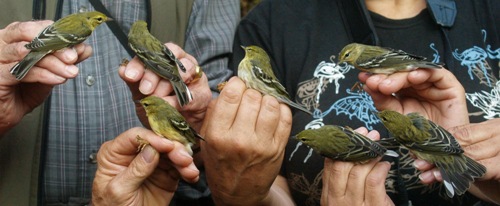
Part of our influx of Blackpoll Warblers.
(Photo by Simon Duval)
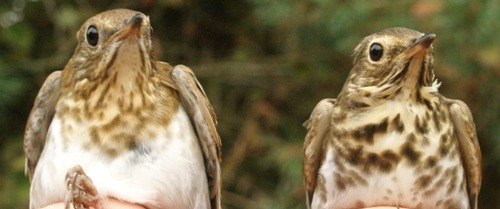
A nice comparative portrait of two thrushes present at MBO in record numbers this fall: Veery on the left, and Swainson's Thrush on the right.
(Photo by
Simon Duval)
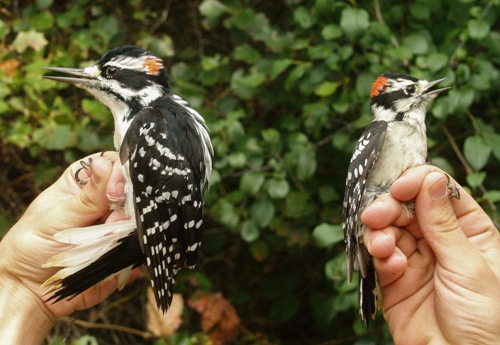
Another good comparison, showing the difference in size (and for that matter plumage on the head and tail) between Hairy Woodpecker on the left and Downy Woodpecker on the right.
(Photo by
Simon Duval)
|







